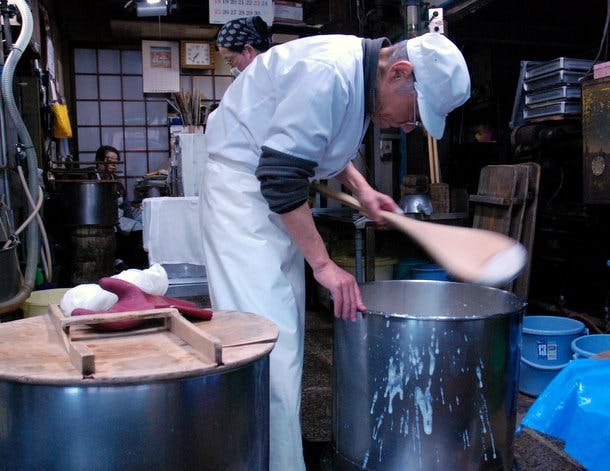
kyoto tofu maker
Explore the traditional craft of tofu making in Kyoto's historic machiya. Visit a centuries-old tofu workshop where a tiny man in a white cap busily prepares tonyu (soy milk) the old-fashioned way. Learn about the traditional process of making yuba (tofu skin) and nama fu (wheat gluten) and the use of nigari as the coagulant. Discover the rich history of Kyoto's tofu industry and its importance to the local community.
Wandering Kyoto's narrow lanes at seven in the morning, I passed a row of machiya -- the city's centuries-old traditional wooden merchants houses. Lights shone bright inside one of them, the place buzzing with industry. I pressed my face to the window to watch a tiny man in a white cap, shirt and shop apron busily preparing tonyu -- soy milk. He looked up, smiled and waved me inside.
One of my great pleasures when visiting Kyoto is to amble aimlessly through its old neighborhoods first thing in the morning. This is a city that makes things, a city where traditional craft endures. Walking the streets I've watched craftsmen and women in ground-level workshops produce tofu, yuba (tofu skin, a delicacy), nama fu (wheat gluten, another delicacy), bamboo baskets, cabinets, paper -- and more -- the old fashioned way. Just like the tiny man in the white cap.
I slid open a glass door and entered his machiya. Inside, the sweet fragrance of soy milk hung in the humid, warm air. I walked on the old stone floor -- stones as big as suitcases, glistening and wet -- to a corner of his workshop, and watched. The man cooked tonyu in a complicated stainless steel contraption and poured the hot milk into three foot high stainless steel vats. As it cooled, he skimmed the surface to collect the yuba and portioned it on styrofoam trays. On a table near the entrance stood a collection of odd-shaped jars that once held baby food, coffee and pickles, and were now filled with tonyu. Neighbors dropped in to pick up a jar and drop off an empty one and a coin in its place.
After a half an hour, the man paused to dip a measuring cup into a vat and pour steaming soy milk into a coffee mug. "Dozo" -- please -- he said and handed me the mug. The soy milk tasted nutty and fresh and delicious, nothing like the packaged stuff I buy at home. He explained things in Japanese I didn't understand, sadly. He then proudly pointed to four plaques hanging on the wall. Why he won those awards -- that I could easily understand.
A little while later three women in flower-print smocks and kerchiefs covering their hair joined him in the workshop. They poured soy milk into molds and added the agent that turns it into tofu (what is that called?). I bid goodbye and stepped out again to the street, the morning crisp and cool.
On November 30th, I received a gracious email from the tofu maker's family. I thought I'd share it with you:
Dear Mr. Harris Salat
I am one of the family members of the white cap tiny man of the Tofu Maker who you visited in the morning the day 16th of this month.
I visited your homepage for the article of our tofu factory. I appreciate your article for presenting his factory very nice. Regarding the word "agent" you referred to explain of which is to turn it into Tofu, we call it "nigari" in Japanese, which may be called "bittern", which is taken from sea water, whose content is Calcium chloride and Magnesium chloride.
The factory have been there for 90 years. I am sorry that it is supposed to be closed in the end of this month because he is too old to continue and nobody wants to continue the factory.
Anyway thank you for having visited the factory. And hope you will keep introducing Japanese and Kyoto food and dish to the world.
